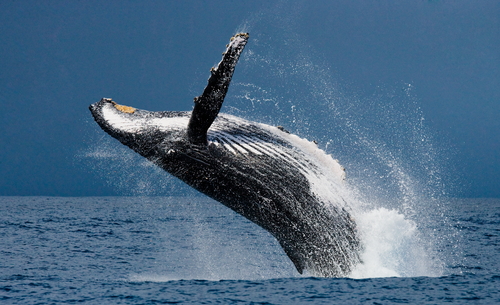
Whales are large aquatic mammals. They breathe through their blowholes into their lungs. Unlike fish which breathe through their gills under water, whales need air, which is why they surface from the water after a certain period of time. This guide will help you find out more about whales, such as their habitat, what they eat, their anatomy, and more.
Species
There are different marine mammals in the Cetacean group, some of these mammals include whales, dolphins, and porpoises. Additionally, there are many different species of whales and some of these include the following; Blue Whale(Balaenoptera musculus), Gray Whale(Eschrichtius robustus), Humpback Whale(Megaptera novaeangliae), Fin Whale(Balaenoptera physalus), Narwhal Whale(Monodon monoceros), Common Minke Whale(Balaenoptera acutorostrata), Antarctic Minke Whale(Balaenoptera bonaerensis), Killer Whale(Orcinus orca), Sperm Whale(Physeter macrocephalus), Beluga Whale(Delphinapterus leucas), and Bowhead Whale(Balaena mysticetus).
There are two types of Cetaceans, baleen whales and toothed whales. baleen whales have up to 600 plates of baleen in their upper jaws, baleen is a substance made up of keratin. The baleen strains seawater and allows the whales to capture their food such as fish, plankton, and shrimp. Toothed Whales are usually smaller than baleen whales and all species of dolphins and porpoises belong to the Toothed whale family.
Habitat
Whales live in water their entire lives and the different species of whales can be found in all the major oceans around the world. There are various different factors which affect the location of different whale species. These factors include; food supply, the size of the whale, and their mating grounds.
What They Eat
Whales need to eat a massive amount of food every day, this should be obvious due to their massive size. Different species of whales eat different types of food, for example, Blue Whales mainly eat krill (small crustaceans) and Humpback Whales mainly eat small fish, krill, and plankton.
Predators
The massive size of whales has made it so that they do not really have any natural predators. However, whales do have other threats that have caused some species of whales to become endangered. One of these threats have been humans, due to reasons such as poaching, the increased number of boats on the water also increases the chances of whales being hit by them and being injured or killed, and polluted oceans which make It hard for the whales to live in their habitats.
Migration
Majority of whales migrate in order to feed and mate. Baleen whales mostly feed on krill which can be found in cold waters. However, the cold water isn’t the best place to mate and give birth, this is because claves aren’t born with blubber to protect them from the cold temperatures, meaning that they will not be able to survive. For this reason, they migrate to warmer and shallower location to mate and give birth.
Migration varies depending on the species of whale, and not all whales within a population migrate. For example, younger Humpback Whales might not travel as far as the adults because they are not old enough to mate and give birth. This means they likely will stay in colder waters while the adults travel to warmer waters.
Biologists now classify the mammal group Cetacea(which includes whales, dolphins and porpoises) as an infraorder under the mammalian order Artiodactyla.
